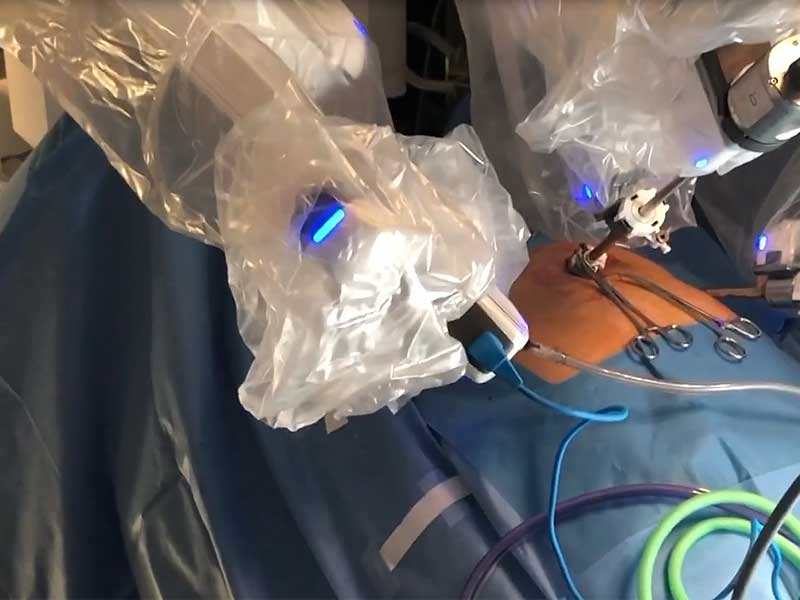Dr. Iraniha performing robotic inguinal hernia repair
Inguinal hernia is one of the most common surgical problems worldwide. Inguinal hernia is essentially a defect or weakness of abdominal wall in the groin region that usually presents itself with a groin bulge with or without pain. There are two standard ways of repairing this anatomical defect, open surgery vs minimally invasive surgery. The ultimate goal in minimally invasive surgery is to decrease the trauma of the surgery to the patients and therefore decrease their pain and improve their outcome.
One way to decrease the trauma is to minimize the size of incision that is necessary for performing the procedure. Therefore, in minimally invasive surgery the surgeon creates multiple small incisions on the abdominal wall to insert special ports for free movement of unique surgical instruments in and out of abdominal cavity during the surgery. This allows the surgeon to perform complex surgical tasks through these small incisions and therefore minimizes the trauma of the operation by eliminating the large incision.
How many types of minimally invasive surgery there are?
There are two types of minimally invasive surgery to repair the inguinal hernia, laparoscopic and robotic hernia repair. The hernia repair surgery starts with general anesthesia and then I make three small incisions on the abdominal cavity and insert three special ports and subsequently insufflate the abdomen with CO2 to create an adequate space for performing the surgery. These ports are designed to allow the special instruments to go in and out of abdomen freely without losing the CO2 during the procedure.
During laparoscopic surgery, I stand next to the patient and hold the laparoscopic instruments directly in my hands and using the camera while I am watching the intraabdominal cavity on a monitor, I am able to repair the hernia. However, during robotic surgery after I insert the special robotic instruments inside the abdominal cavity through these special ports, I connect them to the robotic arms and I leave the patient`s bedside and sit on a console that has a three D monitor and two joysticks.
The robot is essentially a slave and is not pre-programmed, but it has the ability to translate the movement of my hands to the movement of the tip of robotic instruments and allow me to perform the surgical tasks. The actual robotic operation and laparoscopic techniques are exactly the same. I open the peritoneum that is a thin smooth sheath covering the abdominal muscle from inside, right behind the hernia defect and create a pocket. Then I remove the hernia sac and place a mesh and patch the defect close. Subsequently I close the peritoneal opening to bury the mesh behind the muscle. At the end, the instruments and the ports are removed and the small incisions are closed. This operation is done as an outpatient procedure and normally the patient would have a few days of discomfort in the incision area but is able to function normally and perform his regular light daily activity.
At Surgical Oasis Institute Dr. Iraniha who has expertise in performing robotic ventral hernia repair, as well as all other methods and techniques including robotic surgery , laparoscopic surgery and open approach, would give the patient the best possible options and alternatives to reach the desired goals.To schedule a consultation with Dr. Iraniha, please call our office at (949) 646-8444 Thank you.









